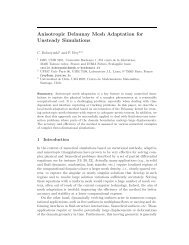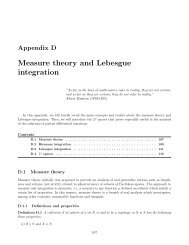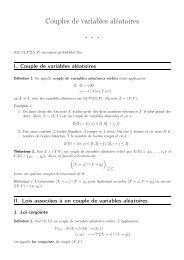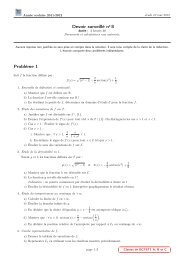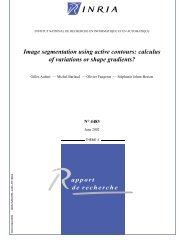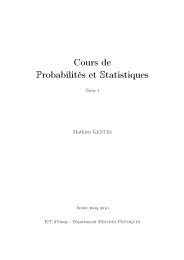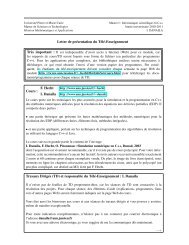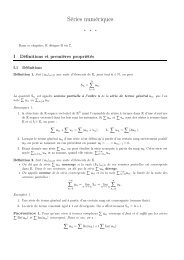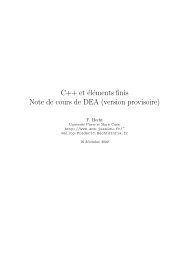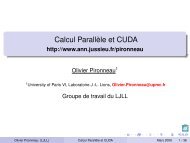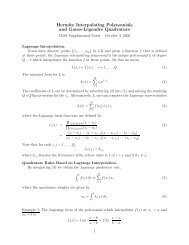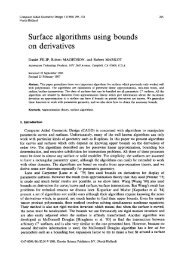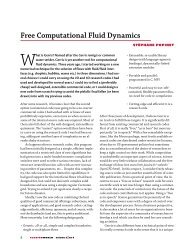pdf file
pdf file
pdf file
Create successful ePaper yourself
Turn your PDF publications into a flip-book with our unique Google optimized e-Paper software.
BOGOLIUBOV SPECTRUM OF INTERACTING BOSE GASES 41<br />
contains all pairs of operators (γ,α) on H such that γ is trace class, α is<br />
Hilbert-Schmidt, α T = α and<br />
� γ α<br />
α ∗ 1+JγJ ∗<br />
�<br />
≥ 0 on H⊕H ∗ .<br />
Let us denote by G0 the set of all pairs (γ,α) ∈ G which satisfy<br />
αα ∗ = γ(1+JγJ ∗ ) and γα = αJγJ ∗ . (65)<br />
The significance of G0 is that for any (γ,α) ∈ G0, there exists a unique<br />
quasi-free pure state Φ ∈ F(H) such that<br />
(γ,α) = (γΦ,αΦ).<br />
Any element in G is also associated with a unique state, but the latter is a<br />
mixed state.<br />
The one-body density matrices offer a simple way to define quadratic<br />
Hamiltonians. More precisely, let H be a self-adjoint operator on H and let<br />
K be a Hilbert-Schmidt operator on H such that K = K T and such that<br />
the following inequality holds true<br />
�<br />
A := ≥ η > 0 on H⊕H ∗ . (66)<br />
� H K<br />
K ∗ JHJ ∗<br />
We shall consider the quadratic Hamiltonian H on F(H) defined by<br />
〈H〉 Φ := q(γΦ,αΦ) = Tr[HγΦ]+ℜTr[KαΦ] (67)<br />
for every state Φ living in the truncated Fock spaces and in the domain of<br />
H:<br />
� M� n�<br />
D(H). (68)<br />
M≥0 n=0 sym<br />
It can be verified that the so-defined operator H is exactly the Bogoliubov<br />
Hamiltonian given in (12).<br />
The main properties of the quadratic Hamiltonian H are given in the<br />
following<br />
Theorem 27 (Bogoliubov Hamiltonian). Let H be defined by (67) and assume<br />
that (66) holds true. Then we have the following statements.<br />
(i) (Form domain). We have the quadratic-form inequalities<br />
C −1 dΓ(H)−C ≤ H ≤ dΓ(H +C)+C (69)<br />
As a consequence, the form domain of the Friedrichs extension of H (still<br />
denoted by H) is the same as that of dΓ(H) on F+.<br />
(ii) (Variational principle). For any (γ,α) ∈ G, we can find (γ ′ ,α ′ ) ∈ G0<br />
such that q(γ ′ ,α ′ ) ≤ q(γ,α) and the inequality is strict expect when (γ,α) ∈<br />
G0. As a consequence, the ground state energy of H is<br />
infσ(H) = inf q(γ,α) = inf q(γ,α).<br />
(γ,α)∈G (γ,α)∈G0<br />
(iii) (Ground state and ground state energy). The Hamiltonian H has a<br />
unique ground state in F(H), which is a pure quasi-free state. Moreover,<br />
we always have infσ(H) < 0 except when K = 0 in which case infσ(H) = 0<br />
with the vacuum being the corresponding ground state.



